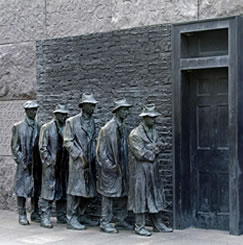
Introduction
The Great Depression was the worst economic crisis in American history. It was made worse by the fact that in the 1920s it seemed as though the sky was the limit for thousands of Americans. They were recovering from a destructive and ultimately unsatisfying military adventure. They had cast off the strictures of the Victorian Age, and they were embracing new opportunities in communications, education, transportation, and countless other areas. The 20s were one of the golden ages of sports, Charles Lindbergh cock at the Atlantic in a single engine airplane, and the Harlem Renaissance promised new cultural opportunities for African-Americans. The economy was roaring, and the world was full of hope. The came the Crash of 1929 and everything went downhill.
The decline was rapid and for a time seemed almost irreversible. The Hoover administration tried to right the ship, but the president was unwilling to take the kinds of drastic steps needed. He believed that given time, the powerful American economy would right itself. As we will see from the documents in this section, people who tried to cope with a bad situation often inadvertently made things worse. Suicides became so common that people actually made jokes about it. Poor people who always had to struggle to put food on the table and clothes on their backs sometimes were more able to cope than people who had never faced such economic conditions before. They knew how to survive on pennies a day, whereas wealthy people had no idea what it was like to find the pantry empty and no money in the cookie jar.
Conditions were exacerbated by the dust-bowl, the windswept erosion of topsoil on the plains that triggered the migration of thousands of Midwestern farmers leaving their homesteads and heading for someplace where they might be able to make a living for themselves and their children. They were known as the “Okies”—made famous in Steinbeck's The Grapes of Wrath. Freight trains had to hire extra guards to keep wandering hobos from filling the empty boxcars. Tent camps and communities made out of cardboard boxes sprang up around the edge of impoverished cities. People who had been able to afford a car in the 1920s were unable to maintain them in 1930s, nor to buy gasoline. Valued possessions were sold for pennies on the dollar so that people could eat.
True, there were areas where the depression was felt less intensely. The trains still ran, factories producing and shipping goods even had a drastically reduced rate, newspapers were still published, radio stations remained on the air, and industries such as aircraft continued to make advances as new kinds of planes were invented. Although the 25% who were out of work suffered enormously, 75% still had jobs, even if at reduced wages. Schools remained open and government offices continued to function. All the same, the depression was deeply felt, and people who remained reasonably comfortable had to be moved by the site of people begging on the streets or standing in bread lines, like the one depicted in the FDR Memorial shown below. They could turn their backs, but they couldn't get the images out of their minds.
When Franklin Roosevelt arrived on the scene in 1933, he offered hope, and things gradually began to improve. But often one step forward meant two steps back, and by the beginning of his second term in 1937, thousands upon thousands were still struggling. The depression eventually ended, but while it lasted, it was brutal. Some years ago a student in one of my classes stopped by my desk at the end of one of the class on the depression. She said, "Whenever I would go to the bank with my grandmother, she always counted money three times. It made me very impatient, and I couldn't see why she did that. But now that we've studied what it was like in the depression, I understand why every dollar was precious to her. She obviously remembered things that I had never known." People who lived through the Depression never forgot it.
| Twenties-Depression Home |Twenties | Depression| Updated November 2, 2021 |
